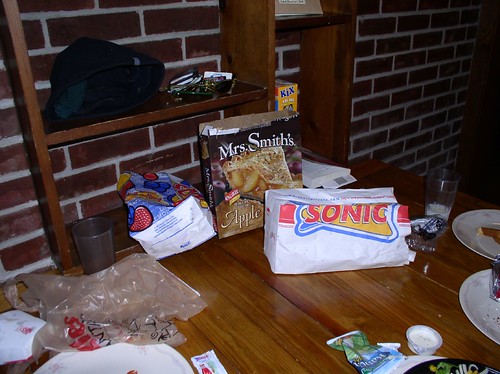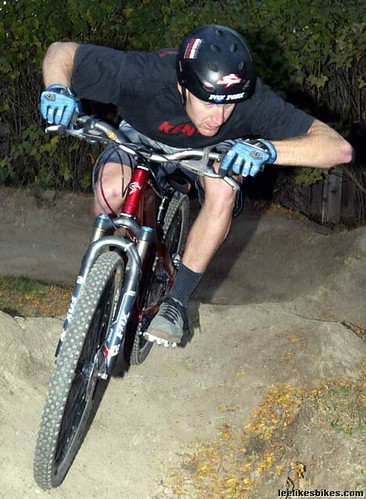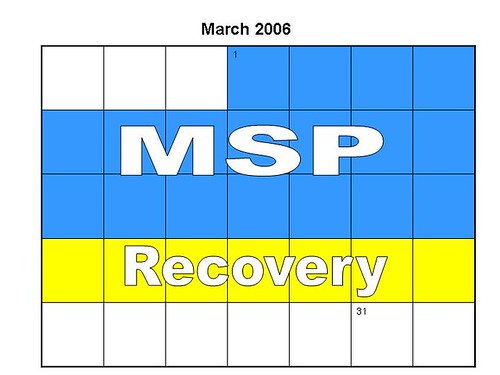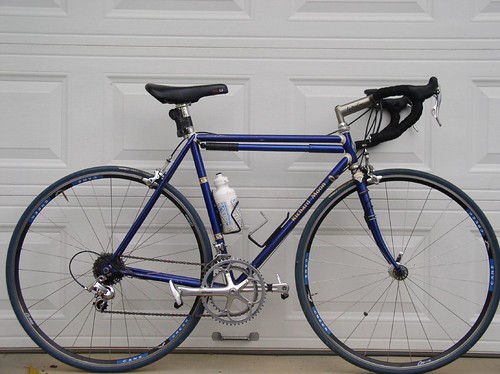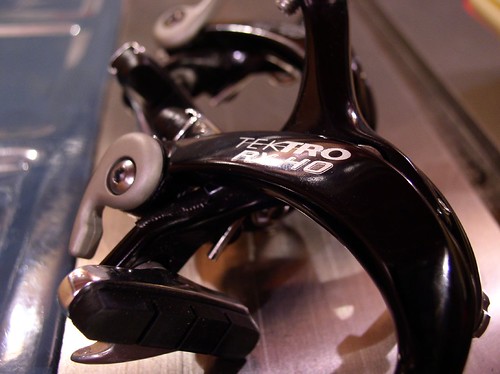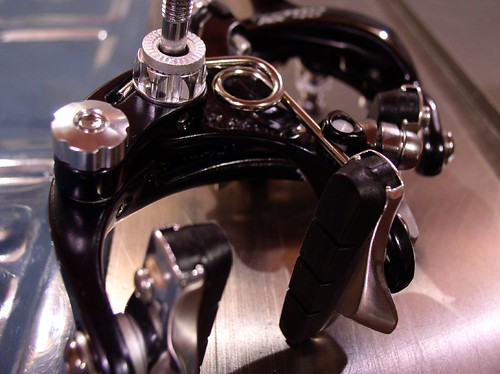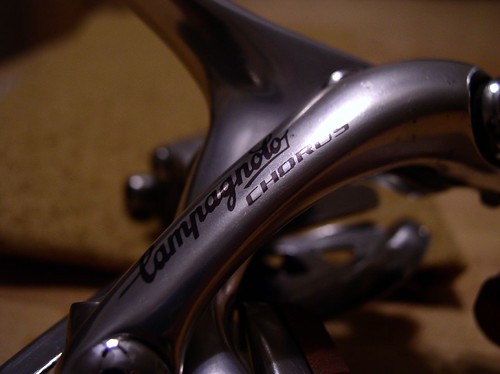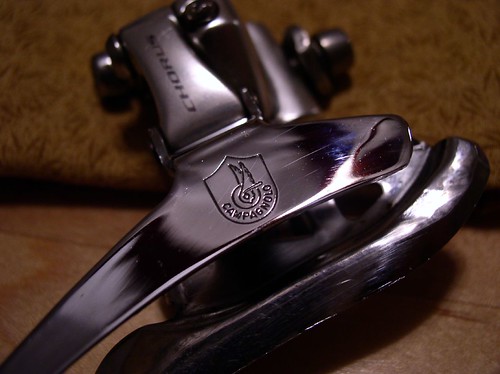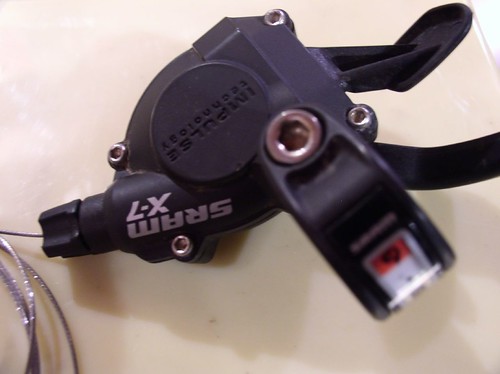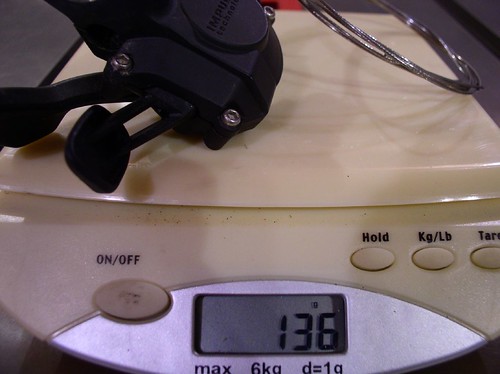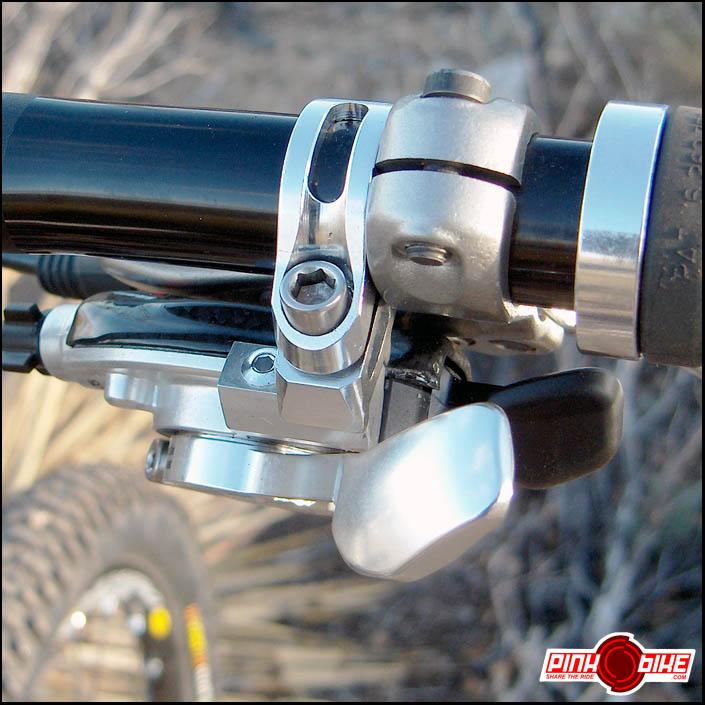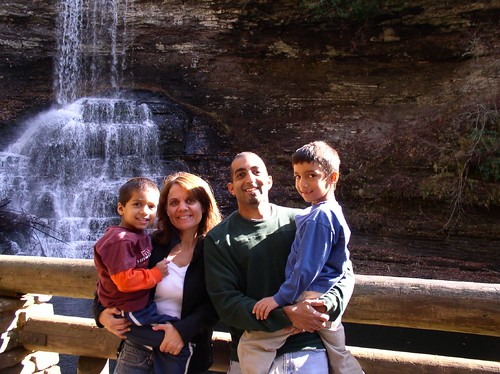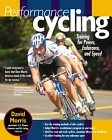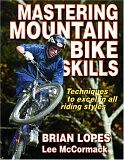I first heard about the Morris method years ago on posts at the
mtbr training forums. There was a vet racer that had been coached by him for many years and he posted a ton of stuff on his experience with it over the years.
One time I went through the archives at mtbr and cut/pasted anything to do with the Morris plan to one file. Here it is in all its glory. It really helps provide another example of how to take the Morris framework and tweak it for a particular event and individual. Again just take it with a grain of salt and use it as an example.
--------------------------------------------------------
The MTBDOC
Apr-28-03, 06:10 AM
"General principles"
Manipulating the work : rest times can vary both the power you can train at, but also the physiologic adaptations. For example, a 3 min interval with 6 min rest can be done at a bit higher than VO2max power, whereas 3 min with 1 min rest is just a bit over LT. For the shorter intervals to build VO2max power, use a 1:1 ratio; the ordering of reps, sets, etc is a personal thing and just needs to be sorted out by trial and error. For a strong sport-to-expert racer, shoot for 20-something minutes of intervals, maybe up to 30-32 by the end of the cycle. The LT intervals (longer efforts), not a lot of rest is needed, it is more for your head than your legs...5 min or so between efforts is probably enough.
Consistent 3 day blocks is a lot to recover from. Mixing 2 and 3 days may be better. You really need to be able to measure your power output, otherwise you really aren't going to know if you are able to make enough power or not. This gets back to HR mythology: "I couldn't get my HR up so I must be over-trained" is meaningless. The important question is: can you make the expected power during your training efforts? If yes, do the workout. If you are falling 10% below, you need to rest.
I am increasingly convinced that racers will be faster on a Huffy (alright, not exactly a huffy, but a $900 bike) with money spent on a Power Tap, SRM, or Polar power measuring system, OR a computrainer (with the necessity of doing MOST workouts indoors). Being able to monitor / measure workout intensity is just too important. Then get a coach that can design a program around these parameters, or really educate yourself (not from cycling magazines, but from physiology journals, books, seminars, etc)...all said with my usual disclaimer that this does NOT apply to the recreational guys that just want to do 5 races a year and have fun...this is for us Type A, compulsive guys that want to win and are willing to pay the price.
MTBDOC
Apr-08-03, 08:04 AM
"LT work"
Time to modify the work. After the shorter, high intensity work, you need to do longer efforts at lower power with less recovery. Generally I will have a rider move into 8-10-12-15-20 min efforts, depending on the level of experience, years of training, etc. Individual workout structure will include rest = 1/2 work period; eg. 8 on, 4 off for 2-3 reps, although longer intervals really don't generally need more than 5-7 min of rest. During this phase, the work periods gradually lengthen, as does the total volume of this work.
Physiologically, here's what's been happening and where you are going: The shorter efforts are maximizing your aerobic power production (VO2max)...of course, there is oxygen debt occuring, but that is an important training stimulus. As you do longer efforts, you aren't changing your maximal aerobic power, but you are increasing % of VO2max power you can sustain, and the time you can spend there.
The long term training then involves a mix of work to both maximize VO2max power, LT power (as a % of VO2max power), and anaerobic capacity and tolerance (basically this means the ability to go WAY above threshold for a period of time and quickly recover to do it again. VERY important in mtb racing). Again, this is where a knowledgable coach and important data (ie power output) can really fine tune what you do
"A couple of principles"
Anaerobic capacity/tolerance is going to be trained by doing HARD efforts with insufficient recovery to completely "restock" all of the energy substrates: ATP, creatine phosphate, and "un-metabolized" lactic acid. Hard efforts at >120% LT power will help build this. Shoot for intervals at a power level that are getting hard in 1 minute, recover 1 min, repeat. Try doing 6 reps; also try it with only 30 sec recovery...the last few will have you looking for a gun to shoot yourself!
I would suggest taking a rest week, shift to the longer LT work for a month, then going back to the shorter work. Play around with recovery and get a feel for it. Again, this is where power-based training is helpful, as you have an accurate yardstick. Constant speed on a trainer is a fair approximation of this. HR is a totally inadequate to gauge your effortts, as it will continually climb while doing the shorter intervals, having you overshoot power early and undershoot it late.
""Old school" concept of base training"
Mountain bike racing is a [relatively] new sport; power measurement and power based training is new. You need to recognize that Pro level road racing involves LONG races; look at how many 5+ hr stages there are in the Tour. There is a greater need for endurance for that type of racing. Also, there were mistaken beliefs that people used to train under, such as "producing lactic acid will destroy developing capillaries in the muscles" and such mythology. This is not based in reality.
Rather than looking at "base" as just long, slow riding, view it as the ability to ride at race distance or longer AND make some hard efforts. There IS benefit from doing long [over-distance] rides. As we discussed on this board a couple of months ago, having some intensity during the high volume phase is fine, as long as the target duration can be achieved. In fact, I believe that many riders compromise their training by NOT doing any hard work during this phase, losing strength and power gains made in the weight room. To give you an idea, in a yearly program, a rider might do 12-15 long rides during a single one month endurance phase, with the occasional endurance training session worked in during the rest of the year. My guess is that you get in some rides of 3-4 hrs duration at times. That does contribute to endurance.
Another HIGHLY useful piece of doing a month of long rides is the weight loss that can be accomplished. It is not that hard to drop 4# per week doing this...and most racers can benefit from weight loss.
Doing 2-3 months of long rides [old school] is not useful for most mtb racers. Similarly, the idea [posted elsewhere on this thread] that you cannot benefit from more than 2 months of interval work is ludicrous. Interval work can be beneficial year round; some shorter, some longer. But realize that virtually all of that work is at or above LT, ie has some anaerobic production. Actually, most riders are producing power above threshold FAR more often than they realize. I challenge anyone here to ride a mtb with a power measuring device on a typical race course [or trail, for that matter] and NOT exceed threshold power. Even beginners (especially beginners!) are probably DOUBLING their threshold power at the start of a race, and during short, steep climbs, etc. Adding in a phase of endurance training DURING the season is generally counter-productive.
Now, let's personalize this for you. You don't really describe what it is that your rides consist of, and without real power data, assessing the intensity is impossible. BUT if you are a racer, and added a month of high volume in the winter, you might see [choose 1]: little improvement, some improvement, much improvement in your race results. That is the individual nature of this stuff. I DO know that doing higher power efforts [intervals] in a structured and repetitive fashion makes riders faster, and believe that most will gain some benefit from the endurance phase.
If you are a solo 24 hr racer, then endurance becomes a MUCH more important issue; that's the specificity of training. In a 24hr race, you want to minimize riding above threshold, as it digs too deep of a whole to recover from. LONG training rides are MANDATORY then.
MTBDOC
Mar-15-03, 01:04 PM
"Just got back from a 2+ hr tandem ride..."
...let me put my brain in...okay...for a recreational rider, if you are willing to put in 2-3 hard trainer rides per week, you can get REALLY fast (relatively speaking). You will get the most bang for the buck with doing hard interval workouts...not much to be gained by just poking around on the trainer. Now, you obviously need to get on the trails...guess you are hoping to ride at least once each weekend (or both days, if you're lucky!). Try something like this:
Monday: 5 reps of 3 min on, 3 min off (figure 15 min w/u, 10 min cool down.
Tues: easy spin 15 min or so (if you don't have time, don't worry; this should help with recovery)
Wed: 6 reps 3 on, 3 off
Thurs: 6 reps 2 on, 2 off (should be slightly faster than the 3 min efforts)
Fri: easy spin if you feel like it.
This basic structure will work quite well with 1 or 2 weekend rides thrown in. If you ride Sunday, the intervals Mon will hurt, but over a couple of months, you will see improvement.
The next 2 weeks try adding a rep if you can. 4th week rest Mon/Tues, Wed do 5 x 1 on, 2 off, rest Thurs and then get back in the swing.
Over time, you can bump the intervals up to 4,5,6 minutes...keep total work period under 30 min per workout. Try for a speed on the trainer that you can consistently BARELY finish the last interval. It'll take a while to get this sorted out. You will tend to fade quicker during a workout the first few weeks, but stick with it. Shoot for 2 or 3 quality workouts during the week. You might try doing them in the am before work. And the usual warnings about MD checkup, make sure your heart is okay for hard efforts, use at your own risk, etc.
Dave Morris' book on training is due out soon. Check Amazon, etc over the next few weeks. This will do a THOROUGH job of explaining the relevant principles.
MTBDOC
Mar-12-03, 05:00 PM
"Maximal force generation needs SHORT efforts..."
on the order of 10-20 sec. Intermix interval sets with short recovery (20 sec or so) and longer (60 sec). The seated low cadence high resistance is not about force generation, but for making the "fast twitch" fibers develop better endurance characteristics.
Try something like this: 10 sec (seated) hard as you can, 60 sec recovery; do 4 reps; spin 5 min between sets; do 3-5 sets, depending on your years of training, recovery ability, etc. Another day do 20 on, 20 off. same idea about rep #'s. This can be done in conjunction with high volume training. I've done these workouts both before or after 2-3 hr steady rides
MTBDOC
Mar-10-03, 05:05 PM
"General ideas"
As noted in MULTIPLE discussions to be found below, there is some difference of opinion about duration and intensity of intervals this time of year. My recommendation is to do primarily 2-4 min intervals with equal work and rest periods. The number depends on you: age, years training, level of racing, etc. A good starting point would be to warm up about 15 min, then try 6 repeats of 2 min on, 2 min off. For the work period, select a gear that doesn't feel too horrible at the beginning, but is hurting you pretty good after 2 min. The goal is to maintain the same speed throughout all intervals. The rest period is EASY...whatever gear that means...just spinning your feet. Now, that's only 12 min of intensity. If each interval has felt hard, but you feel like you've got a couple more in you, do 8. Do an easy 10 min spin at the end. Try about 10 1-minute intervals the next day. Rest a couple of days. Monitor how you feel. Gradually increase the amount of work done each session. Perhaps up to 20 min for a beginner, mid 20's for sport, 30 or so for expert...now, these are just ROUGH guidelines. The goal is to increase power (=speed) over the course of weeks and months. Also, you want to do some longer efforts as well...end of generic comments!
MTBDOC
Mar-05-03, 06:09 AM
"Consistent power output during intervals is key..."
Trying to do structured training on trails is very difficult for the reasons you've noted. If you had a power measuring device, you'd see all sorts of variation in power output. That simply is NOT going to produce the optimal training effect. I'm not saying that MTB riding has NO place in training, but you will do FAR better on a trainer, or on a steady road climb. Maintain a steady speed on a evenly-pitched climb, and you will have a relatively steady power output.
Your experience of the intervals on the trainer is quite instructive: doing intervals at a set power DOES feel easy at the beginning of the first interval, and deadly hard at the end of the last one. You are accomplishing the most training effect that way.
I DO incorporate HARD mtb rides in training...in fact I'll do a hard ss ride today and structured intervals tomorrow. I've done 10-12 min climbing repeats on the mtb (as I HATE doing extended LT intervals on the computrainer). Also, keeping the bike hooked up on steep, technical climbs provides some technical skill training WHILE you are loaded with lactic acid (which ruins coordination!); this is a good simulation of what happens in races.
I believe that the most benefit IN THE LEAST TIME can be accomplished with structured trainer workouts. Working in the occ'l mtb ride adds another dimension.
Now, for any stud roadies coming over to mtb racing...forget this. Your limitation is going to be skill and the specific type of power needed in mtb racing...incorporate more mtb efforts.
MTBDOC
Mar-03-03, 10:10 AM
"During high volume phase..."
as it is easier to do the long, steady hours without having much glycogen available. Just did about 8.5 hrs over the past two days...bonking like crazy the last 1.5 hrs or so...forces mobilization of adipose tissue (and freeing fatty acids from triglycerides so they can be burned). I find that losing weight is easiest at this time of the year. When the VO2max intervals begin (this week, for me) I have to do a better job of managing dietary intake...eat enough to have enough stored glycogen to get through all of the anaerobic work; don't eat enough to gain back the bodyfat.
The upperbody lifting is a tough issue. I can see at least 5 lbs extra muscle mass I'm now carrying, which I DON'T want to give up...but it DOES SLOW YOU DOWN. That muscle does not increase LT power (or sustainable power, or however you want to classify it) so it LOWERS the power/weight ratio = slower climbing...pure physics. BTW, look at Lance's arms during the Tour...they are totally scrawny! His genetic makeup is to be heavier than that, which is why he works hard so his body DOESN'T put the muscle back on.
There is no evidence that junk food impairs recovery...in fact, right after a training bout is a good time to eat some of that stuff, as long as you are getting enough protein and not too much fat. For example, if you REALLY like pop-tarts (ugh...but some folks do!), eating a couple right after the workout is fine as this a ready source of high glycemic index carbs...just get some protein as well.
MTBDOC
Feb-26-03, 06:05 PM
"I think you're missing the point..."
"All out" means the max you can do to complete the interval and workout...not starting at 600 watts and ending at 200...that's why power measurement is critical for training. Actually, I try to get my riders who don't have power measuring to simply set up the trainer equally each workout...same pressure from trainer to bike, same tire pressure, etc...and maintain a given speed.
You can't go all out more than 10 sec or so, I guarantee it. I can hit >1000 watts...but for how long?
BTW, another approach is if you have a steady climb with a constant grade...just maintain the same speed...feel easy at first, hard in the middle, and "wanting to die" by the end.
MTBDOC
Feb-25-03, 05:59 PM
"Yo, homey!!!"
Absolutely...and don't buy all the software...let me explain.
The computrainer is VERY accurate at it's power measurement capabilities, and that's what I use it for. It has the "ergometer" mode, which I believe is THE BEST approach to training. Basically, you warm up, re-calibrate (takes 10 sec!!!) and then set the watts from 50 to 750. For example, say you are paying me to torture you (WHAT A COUNTRY WE LIVE IN!!!) and I prescribe 2 sets of 6 x 2 on, 2 off. You (and you get this figured out after a bit of trial and error) decide to do this at xxx watts (if you are Lance, probably 500; a beginner, 260). You simply punch this in on the control pad (on your handlebars) and CRANK! The device will increase pedal resistance if you slow down, and decrease it if your cadence speeds up...this keeps you at a constant power. It is MAHVELOUS! for training because of this. Trying to hit power targets is a bit harder, and there is a tendency late in the interval to let the # drop a bit.
Now, there is another mode where the power is determined by setting, gearing, and cadence (in other words, a computer setting and rear wheel speed). I find this usefull for the 10-20 sec intervals, when you'd spend all your time pushing the buttons to change power. I can ramp up from 100 watts to 400 watts in 4-5 sec, which works well for longer intervals of a minute or more.
I haven't checked prices...I've had our older one since '93, and the "Pro" model since '95. I sent the old one back several years after buying it for re-calibration...NO CHARGE!!! These folks are the real deal...only downside is that you can't (easily) take it to a race to warm up...although I now have a small power inverter in my van and have thought about it...another thought is that it's actually rated for tandem use...may do some training together with my wife! As we've been doing it "side-to-side" on our computrainers, might be fun training on the tandem occasionally!!!
MTBDOC
Feb-16-03, 04:53 PM
"Need to focus on power output..."
and the best way to build this is through moderate length intervals. Without knowing how many years you've been racing, what level, etc, I can only make general comments.
You need to do intervals in the 2-6 minute range with an equal work-to-rest period. For example, do 6 reps of 4 min on, 4 min off. Try to perform them in at least 2-day blocks (the second day might be something like 6 reps of 3 on, 3 off or 8 x 2 on, 2 off). The second day volume should be slightly less and the intervals shorter...higher power output, though.
To figure out how hard to go you need either a power measuring device OR an even grade...go by speed in that case. The goal is NOT a particular heart rate (and NO, I don't want to discuss HR's!!!), but a constant power output throughout each interval in the workout. HRM's are tremendously misleading, as your heartrate is a poor reflection of power in the shorter duration. Learn by feel, or by a computrainer/SRM/Power-tap. More power-based trainers are coming on the market, but I don't know about their accuracy.
For the overall structure, try something like this: go 2 days on, 2 days off, 2 days on, 1 day off; week one down and you're tired! Now do another 2 day block, but go back to 2 days rest; then do one day of work, and rest the next 2 days; You've now done 7 workouts in 2 weeks and you're thinking "I'm finished!"...hang in there for one more week and repeat week one. Then rest 2 days, 3rd day take a brief spin to loosen up and warm up, then do 5 x 1 min on, 2 min off, cool down, then rest a few more days. At the end of this 4 week cycle you will have made huge gains in your power output.
MTB racing requires a lot of effort around and above threshold. To be a successful racer requires training that kind of power. Now, there is a lot more to putting all of this together and often requires some tweeking and on-the-fly changes, but this gives you an idea. AFTER that 4 week block, work on longer intervals in the 8-12 min (or 15 min if you race expert, 18-20 for pro) with work = 2 x rest duration (eg 12 min on, 6 min off).
Group rides and racing can fit in with this. I have frequently done intervals the day before an early season race if that was what I had scheduled. Train through these races and taper for the bigger ones
MTBDOC
Feb-18-03, 04:56 PM
"Answer within..."
To develop the ability to make and sustain power above anaerobic threshold requires a fair amount of volume of that level of intensity. If you review my past postings, you will see me advocating 20-30 min of anaerobic work, generally 3-4 x per week. Generally those intervals are in the 1-6 min range. I am not a fan of the pyramid simply because I believe in training by power, not heartrate. The difference in power output for 4 min vs 1 min is significant. For example (looking back through past logs), I worked up to about 330-340 watts for 4 min, whereas 400-430 for 1 min (depending on whether I used 1 min rest or 2 min rest). Sorting out the specific power level for a given workout is difficult, and the goal is steady power throughout that workout. Such tremendous variation in duration makes figuring the power impossible.
For example, if you go hard enough for 1 min that you're ready for your rest, 2 min at that level is about impossible...much less 3, 4, etc. Similarly, if you do the "4 min" power for 1 min, you are not going to get an optimal training stimulus. In a weight room, doing pyramids is easy because you simply add or subtract a plate. The only reason I could see on the bike is to fight boredom.
The 15 min low cadence, if done at about 50-55 rpm, will develop strength-endurance. This is different from power. It is to help the high power, "fast twitch" fibers develop greater aerobic capacity. I would suggest shorter rest periods. Long intervals generally work well with a 2:1 work:rest ratio. Otherwise you are just killing time.
You note you are training 9 hrs / wk. Unless I am doing specific endurance training, I don't pay attention to total time, just the volume of specific work. I also believe it makes better sense to do the high intensity work first, to develop the power, THEN the longer workouts to focus on riding hard, longer
MTBDOC
Feb-20-03, 07:58 AM
"No, he's talking about whole training phases, not day-to-day"
Your point has some validity for in-season training with multiple goals/needs. For example, during the race season, a rider might do a two-day block with both short, high anaerobic intervals one day, and longer, AT-type intervals the other. Generally it DOES work better for the higher power work first. However, it is worth experimenting for each rider. This is where power measurement is absolutely mandatory. If you have an accurate, objective measure of watts, you can compare workouts over time and see if you can meet the power targets by changing the order of the workouts. Kind of like doing a TT one day and crit the next; then reversing the order at the next event.
BTW, for those of you who do use power measurement, in my usual disregard for Friel's writings, since he FINALLY got on the power bandwagon, he talks as though he has the holy grail of "critical power" figured out. My approach for the desired power of ANY workout is performing each interval at the highest power that can be completed for the entire workout. Actually, a rider who tries a slightly higher power level and can't quite hold it the last interval or two may or may not get a better training effect. This is where the "art" of training comes in. There is just no data to clarify this, and probably never will be.
MTBDOC
Feb-20-03, 07:27 AM
"Need to develop the power first"
Again, the high power (anaerobic) intervals are done to DEVELOP the power. A one-month block of this will substantially increase the power output of most riders. The next phase is sustaining power for longer periods...if you don't develop the capacity to MAKE power first, you won't be as strong
MTBDOC
Feb-05-03, 05:53 PM
"Sorry I haven't had time to monitor this board lately..."
Everyone repeat after me: "Power moves bicycles!" Very good, class. Now, what does this mean in a practical sense? The goal is to produce as much power as you can for an extended period of time.
To make power requires muscle mass that can contract powerfully. This is developed through structured weight work to grow the muscle, increase recruitment of fibers, and then contract with maximal force and speed. This is intermixed with extremely high power, short intervals.
Then the cardio-vascular endurance base with periodic high power efforts to sustain the gains from the weight work.
Then intervals of moderate duration that develop high, sustainable power output.
AND FINALLY, long intervals that are structured to enhance "tolerance" for sustained efforts. These are the so-called LT intervals. Funny thing: these have been called lactate threshold and lactate tolerance. I like the latter in that it helps my riders and me remember that half the battle is mental. When I do 10 min or longer efforts, it is a HUGE mental effort, but not overall as painful as some 3 min efforts. But most of us face a huge desire to back off for a bit. This is the difference between winners and losers (of riders with similar physiologic potential and training to this point) when faced with a long, steady climb in a race.
These efforts will mentally tend to burn you out. As such, I don't want too much of it during the season, but it needs to occur AFTER the ability to make high power has been developed.
As an aside: sorry but I think all of this foolishness about "weekly hours" and such makes little sense. A workout has a specific physiologic goal or there is no sense in doing it. But I'm sure you can find plenty of people to tell you to do it otherwise. I simply point to results
MTBDOC
Jan-29-03, 07:27 PM
"Power moves bicycles!"
Base is a term that people may use to refer to a variety of activities. For a mountain biker, endless miles of easy aerobic work only gets you so far. To go faster you need to develop power. Training periodization should go something like this: strength/max power [generally accomplished in the weight room by periodized weight work combined with VERY HIGH intensity intervals in the 10-20 sec range; I have previously posted on the structure of this phase]; high volume [endurance rides; "base" if you like to call it that; about 4 weeks]; "VO2max" phase [interval work in the 2-6 min range performed at 120-150% threshold power; this translates into workouts including 20-40 min of work plus variable recovery periods depending on the specific session; about 4 weeks]; then LT workouts [8-15 min efforts at 110-115% LT power; rest is 1/2 duration of work interval].
I see riders spend too much of the early season doing efforts with insufficient intensity. They never develop the power that they could. Similarly, lack of anaerobic power training IN SEASON also compromises power. Look at the road pros: racing several times per week for many months. Certainly they just "sit in" during some of those races, but there is still a great deal of anaerobic work. They ALSO have a great deal of volume at lower intensities. If you are going to be RACING 20 or more hours per week, TONS of volume is needed. To race a typical 2+ hr pro/ex mtb race just doesn't need that much volume for recreational racers.
My suggestion: spend 3-4 weeks doing some structured intervals in the 3-6 min range [rest period = work period], going back-to-back some days; scheduling an easy week with a single one-hour workout with 5 repeats of 1 min HARD, 2 easy in the middle of the week. Race on the weekends if there are training races around (I really believe in early or pre-season training road races). Then the next 3 weeks, get 3 workouts per week with progressively longer intervals 8-12 min {rest period = 1/2 work period]. Last one about 4-5 days before your race. Get in a decent pre-ride the day before with several hard 1-2 min efforts. Kick butt sunday...next question?
MTBDOC
Dec-08-02, 01:46 PM
"Now to REALLY get someone upset..."
FORGET FRIEL! Go back and re-read my posting. These workouts and the associated cycling mentioned precede a 4 week volume/endurance phase. This consists of 4-5 hr rides Sat and Sun, and some short high intensity work in the week (and hopefully another day or two of 2 hr during the week). During this phase, strength endurance can be done...these are the 50-55 rpm high resistance grinds on the trainer for 8-12 minutes.
After that comes a month of 2-6 min anerobic intervals, usually in 2 or perhaps 3 day blocks, with equal work to rest periods. [For example, do 4 or 6 reps(depending on how many years you've been torturing yourself on a bicycle!) of 6 on, 6 off on day 1; 6 reps of 4 on, 4 off on day 2; 8 or 10 reps of 2 on, 2 off on day 3] This gets you into the early race season. And these workouts can be combined with races (ie do a race instead of an interval workout).
On the other hand, gosh, if a Men's magazine said to do 100 reps, it must be true ;^)
MTBDOC
Dec-07-02, 06:55 AM
"Guidelines and debunking mythology (long and controversial!)"
I guess I haven't addressed this in for awhile, so here goes:
1) Transition phase: Getting yer ole body used to the weights; this is a transition time for a month or so at the end of the racing season. Calling it "anatomic adaptation" is inaccurate. Your "anatomy" isn't adapting. Technically it would be more "physiology". At any rate, you need to do this to get your muscles used to the loads, but even more so, allow some adaptation in your tendons. A perfect example of this was me this summer. When I burned out racing and training, I started doing some upper body work (had done virtually none for 2+ years). I started to put on muscle ("hypertrophy"; see below), but after about 3 weeks of really accelerating the volume and intensity, my right elbow developed severe flexor tendonitis (which is just now resolving). Muscles adapt first, tendons second, and ligaments third.
During this phase, getting in 2-3 rides per week with 10-15 min of intensity will help maintain your cycling fitness...now to the fun!
2) Hypertrophy phase: Hypertrophy means that the muscle cells are growing in size. This gives you more force-generating tissue. Research shows that hypertrophy occurs best using a weight that you can only lift about 10-12 times. To maximize gains, shoot for at least 6 reps (after doing a set or 2 of lighter weight to warm up). Second principle is to do some back to back days...I know, this runs totally counter to "gym mythology" that says never work the same body part back to back. But it works, just like 2-3 anaerobic days on the bike builds sustainable power. I generally do a 2 week phase, lifting for 2 days, 1 day off, 2 days on, 2 days off, then repeat the week. DO NOT RIDE HARD DURING THIS PHASE. Just get in an hour or so a couple of times per week on rest days.
3) Neuromuscular adaptation: What this is all about is teaching "recruitment" which means getting all (actually most) of the muscle fibers firing at once. What limits maximal force generation ("Strength") is that all the muscle fibers won't fire at the same time. You can rapidly produce an adaptation between the muscle fibers and the controling nerves by exceeding the force requirements you're used to. So, to actually do this:
Lift every third day or so. First two workouts, warm up, then do sets of decreasing reps: 6, 5, 4, 3 in increasing weights. You will feel like you are going to "bust a gut" but that's what is needed in order to produce this adaptation. Last 3 workouts, do 4, 3, 2 reps...these are going to be HEAVY weights. On your off days, get in some volume riding (2 + hrs 2-3 x week), relatively easy rides, but throw in a few hard bursts. If your are compulsive (like me), get 1-2 workouts per week where you do 3-4 sets of 4 reps, 15-20 sec maximal efforts, with 20 sec recovery on the trainer. Do this the day after lifting
3) Power phase: Power = force x speed...what is needed here is moderate weight (roughly 50-60% of the highest weights from the previous phase), done 8 or fewer reps, EXTREMELY FAST! The gym rats will think you are an idiot. When I do this, the weights clank on squats as I'm flying up; on the leg press machine, the foot plate actually separates from my feet at the end of the rep! This gets your muscles producing force at a speed more akin to that required on the bike.
Try to workout like this 3 x per week (x 2 weeks). Do something like 8, 6, 5, 4 reps with increasing weights. You will be really blasting 'em up, and breathing VERY hard at the end...also want to get in a couple of rides, and a few of those maximum burst intervals addressed above. Also this is a time to throw in a "strength-endurance" workout (8-10 min, 50-55 rpm high resistance intervals on the trainer; rest duration = 1/2 work duration; stay in the saddle, and don't do it if your knees hurt!)
General issues: I do squats, leg press, and leg curls. I STRONGLY recommend against doing any leg extensions, as these produce very bad shear forces on your knee and are not a physiologic movement. If you choose to do some upper body work, fine. I stopped doing it as an effort to keep excess upper body muscle OFF (contrary to what gets said out there, not THAT much upper body strength is needed for XC racing). Do some core training year round (abs, lower back, trunk rotators). I do NOT believe that weight work benefits cycling in season, as the cycling specific workouts get you where you need to be.
Next phase = high volume block (4 weeks) WITH maintenance of benefits!
MTBDOC
Dec-10-02, 06:19 AM
"Re-read above..."
You should have enough detail...Two weeks for each phase, so that you are doing 2 weeks of 4 x per week (2 on, 1 off, 2 on, 2 off) in the hypertrophy phase; 2 weeks for strength, 2 weeks for power; one month volume; then into "VO2 max" work.
Part of the art of training/coaching is coming up with a schedule that works for you. I actually DO a bit of coaching, but continued to have Dave set up my training (until I got fried this summer) as it took a HUGE burden away from me...the problem is when I set up my own schedule, I tend to second guess myself.
As for fitting in to a "real world" life, a friend of mine has been working with Dave for about 3+ yrs now. This guy is an ER Doc in a small town, and works a ridiculous schedule. However, his work schedule is set a month in advance, so that he and Dave have developed workable plans month-to-month for training.
Currently I'm doing some adaptational weight training (began after I returned from doing El Tour de Tucson a couple weeks ago); I am just beginning to lay out the next several weeks. It does get interesting with holidays, etc, coming up. The first year I did this type of lifting, I could barely get out of bed after the 4th workout in 5 days (the first week). It was Christmas eve!
As for written guidelines, I can't really help you there. McGraw Hill is publishing Dave's first book late winter or early spring. I'll post more info when I have it. If you are serious about having me help you set up a schedule, give me your email. I don't do this as a job (which Dave does), but would be glad to discuss goals, etc and see if I can help you.
MTBDOC
Oct-31-02, 07:56 PM
"Time to spread some wisdom ;^)"
WARNING: The info contained below is simply my opinion. Although doing what I describe helped me develop into a top masters mtb racer, I finally burned out this summer, and can't do this stuff at this point in my life...maybe next spring.
If you've been around in the old days when I used to post a lot, I talked about doing 2 and 3 day training blocks. Frequently this is incorporated into race weekends: pre-ride HARD Sat, race Sun, intervals Monday...then a couple of days of rest, perhaps a bit of hard work Thurs, easy Fri, and repeat. FORGET what you've read about not doing consecutive hard training days. In my mid-40's I have often done 4 days of anaerobic work in a given week, with each workout having 20-30 min anaerobic effort.
Overtraining is MOSTLY a mental issue. In my case this fall, I have simply been unable/unwilling to endure the suffering on the Computrainer that I could subject myself to before. Part of which involves taking on a new job and too many responsibilities (also a reordering of priorities). If you are getting enough carbs to reload the muscles (and if you do back-to-back training, make sure to do the protein/carb recovery drink after the workout, followed by a decent meal), your muscles should recover adequately. My mentor and coach, Dave Morris, conducted research having folks do multiple consecutive days of anaerobic efforts. Although they hated it and FELT burned out, they set pr's in terms of power output. Your body can do FAR MORE than you probably subject it to.
Now, if you have a big race coming up, TAPER...actually, it's about time for most of us to get into the gym as the season is pretty much over. The hard efforts the day after the race (and/or the day before) are crucial for power development in the early race season.
MTBDOC
Nov-02-02, 06:11 AM
"Not so sure about some of this..."
First, I don't agree that training is based on how you "feel". I have had days that I felt like crap going down to the basement (= torture chamber housing Computrainer, gym, etc.) and didn't feel good throught 15+ min of warm up. None-the-less I did the scheduled workout at the appropriate power level. Now I DO think that this behavior can lead to mental fatigue and burnout, but the PHYSICAL adaptation (increasing power output) still occurs.
Secondly, this notion of NOT doing much hard work during "Peak" phase is overblown.
If you NEVER do more than 10 min zone 4+ (of course, that depends on how you define it) back to back, you are limiting your ultimate power development. Consider road events where it's not unusual to do a TT on Fri, RR on Sat, Crit on Sunday. After 2-3 days rest MORE intensity. Try this for a month or two (giving yourself an easy week after 3 or 4 weeks) and you will be shocked. BUT IT IS HARD. Years of this turned me into an absolute beast, BUT it got hard to sustain. This year I had other priorities and stressors in my life and simply got to where I couldn't tolerate the pain in training or the disciplined diet. Result: + 20 lbs; - 5-10% power = MUCH SLOWER. After doing the KY state championships next weekend, then El Tour de Tucson in 3 weeks, I'll hit the weights and reassess goals and priorities for next season. To MAXIMIZE your inherent (genetic) potential takes years and MUCH hard work. Most folks don't have the drive to do so and never get there. That's great; I am just TOO COMPETITIVE! After all, this IS just a sport...end of sermon ;^)
MTBDOC
May-14-02, 01:41 PM
"Recovery issues"
We discussed drinks and such recently and I remain committed (I just drank one as there was NO WAY I could do any food after that workout). The antioxidants are crucial: Vit C, E, grape seed, alpha-lipoic acid; CO Q10 is both about energy and antioxidant effect. I also use HMB: the body builders find it useless but I believe it may do a bit more for endurance athletes (especially us older ones). Glutamine...
Your massage and post-workout cold treatment is great!
YOU NEED MORE SLEEP! 7 hours is not enough for the average person, much less a 35 y/o mtb racer. Try 9!
Probably the biggest issue is that I've been doing this kind of training for about 6 yrs. There is certainly a cumulative effect over time. I currently coach a 32 y/o with far greater genetics than me (ran 33 min 10K on a hilly, off road, cross country course) and we are pushing him to see how much he can handle. He's not been training hard for all that long, so even though he's younger and picked his parents better (at least for mtb racing!), he sometimes struggles to recover from 2 hard days. He just did his first 3 day block and I am waiting to hear how it went!
As for the tires, (and I posted this on "Save some weight") I ran Hutchinson Python (r)/ Mosquito (f) air lights without tubes using the NoTubes system. Still playing with the no-tubes stuff; seems good for our terrain in the southeast.
As for calories, I struggle between taking in enough carbs to get through my training, yet little enough to keep my weight down. I am probably 15# below what my body would like to be (6'1", 152#) but I simply don't make enough power to race at 168 where I look and feel better. Power to weight is VITAL in climbing, which is where most of these races are won and lost.
Suggestion: try some back to back workouts and see what happens. Do some Sat/Sun road races; OR try doing an interval workout Monday after a race. Do some shorter, anaerobic efforts (1-2 min) and see what happens. Anytime you do something like this, give yourself a 3-4 week block, then an easy recovery week.
MTBDOC
May-15-02, 01:50 PM
"Ah, you didn't TELL US!"
...about the baby! Congrats!!! FAR more important than any of this (including winning 3 TdF's: ask Lance!)...okay, so the sleep is problematic.
How do you measure your effort on your intervals? If you are simply going by HR, that's really not a good picture of what you are doing. Do you have a hill you do repeats on? Then time each effort point-to-point. If you do them on a trainer, try for equal tire pressure, gearing, cadence, etc. (again, this is why power measuring devices are so helpful).
I would seriously consider doing a 3 week period with 2 day training blocks. Even if your HR says you're cooked, CAN YOU STILL MAKE THE POWER the second day? That's the key. If you are racing every weekend, that requires a 7 day cycle. Otherwise, try doing 2 days on, 2 days off; do 5 of these blocks (= 20 days), then do a couple of easy spins Mon/Tues, then on Wed 5 reps 1 on, 2 off, with warm up and cool down. Spin (or not) Thur, Spin fri. Pre ride Sat, race Sun and see what happens.
Your body should respond to the back to back workouts. The rest of the riding should be easy. Don't do HR 140's or 170's...keep it in the 120's on your recovery days. Spin on the road but keep it short. 1.5 hr recovery rides may be more than most sport riders need (unless you are working in an endurance ride; then shoot for 3 easy hrs).
Anyway those are my suggestions; they may be worth no more than you have paid for them!!! Best wishes. And spoil that baby!
MTBDOC
Apr-30-02, 02:06 PM
"Coaching"
Ah, the eternal question: can I do this on my own? Will a good coach make a difference? Let me give you some personal observations. I am in my 10th season racing XC and have become an elite age-group racer. I am NOT physiologically gifted: I trained hard for several years as a runner and got down to about 40 min 10k, 19 min 5k. That is simply a fast recreational runner. Probably could have eventually visited the 35-37 min range. On the other hand, I saw people with no background start running and in a few months be WELL below 40 min. These are gifted athletes. I race XC on a regular basis against a guy who ran one marathon...in 2:19. Mere mortals can train a lifetime and NEVER approach that sort of time. So regardless of what anyone tells you, innate ability is going to ultimately have a LOT to say about your success. Lance Armstrong was winning pro triathalons as a teenager. When first tested at the Olympic Training Center, he showed the physiologic potential to be a world champion...but that was NOTHING but POTENTIAL. He has the "heart" of a champion as well. In his case, his coach (Chris Carmichael) helped Lance with the mental side of it: toughness, confidence, encouragement, more than anything else.
Return to my situation: I am a physician who has had an interest in exercise physiology for >20 yrs and have read a great deal in this area. I was self coached for several years, and have worked with a top exercise physiologist for the past 4.5 yrs. Why? His specialized knowledge and the SCIENTIFIC basis of what he does. And results? I have FAR exceeded what I had ever hoped to accomplish, and look forward to some podium finishes at nationals this season. This is because I train HARDER and SMARTER than my competition. I do some coaching myself, and I have had people ask why do I continue to pay someone else. The answer is the same reason that physicians don't provide their own medical care. I want (need?) the objectivity that someone else can provide. We also incorporate some concepts he is just now doing research on (so I am a bit of a guinea pig!) Is it worth it? Think of it this way: guys will think nothing of throwing $2-4k into a new bike thinking it will make them faster. Spending that on the RIGHT coach will make a much greater difference over time.
Another issue: who knows what they are talking about? When I used to do a lot of weight training in the gym, people would look at the biggest guy and assume he had the greatest knowledge...WRONG! Usually he has good genes and was on "the juice". And the USA Cycling "coaches certification" appears to be a joke (having reviewed the materials: LITTLE SCIENCE! Just old school cycling thought). These days there are a lot of folks putting themselves up as "coaches" who really don't know much EXCEPT that they were/are strong racers. But does genetic ability make you a good coach? I have become quite cynical when I see folks putting out information that they have been told by someone else. I remember years ago reading about "Eddy B." telling his riders no intensity in the winter, "because lactic acid will destroy the new capillaries that are being made." HOGWASH! Just like the old saw about not doing 2 hard days in a row. I do 2 and sometimes 3 hard days in a row, and I turn 45 this season! Same thing with the focus on heartrate. It is only within the last year or two that ANYONE has talking about training by power levels. I have been using a Computrainer for this purpose since '94 or so.
So, what's a guy (or gurl ;^) ) to do? First, before you hire ANYONE, talk to him and get some specific answers. What does he base his training on? What is his experience with "recreational" and "elite" racers? How open is he to discussion of the principles? And what specifically does he focus on? As an example, I tend to keep up with the research on nutrition, ergogenic supplements, etc, and don't need that from a coach.
A brief point: a couple weeks ago a female (pro) friend commented that her legs were tired and she had a poor race at a large regional event she had considered an "A" race. Her coach had her doing intervals and lifting weights TWO DAYS before this event. Now, I know of NO research to support doing such a thing. Did he simply overlook her priorities? Or did he purposely do this to sacrifice for later in the year (without discussing it with her)? To me, such an occurrence is inexcusible. Ultimately we are talking about a working relationship between 2 people. Just as a doctor I want my patient to be part of the "team", I think coaching requires teamwork between the racer and the coach, with open, two-way communication.
MTBDOC
Apr-26-02, 04:37 AM
"Power Measurement"
Actually I think that power measurement is best for training. Collecting data during the race could be useful, but using it to control how hard you RACE might not be the best idea. I know that I end up pushing myself harder in a race than in training if I'm really motivated, pushing for the lead, chasing someone, etc. You might end up telling yourself you can't hang on the key climb by looking at a power meter, but in reality you might be able to.
Okay, what are the options:
1) SRM: crankset made in Germany. Measures power by the amount of strain (bending force exerted on the crank). Entry level model only available for road. Accurate, reliable. Been around a long time. MTB model much more expensive, so I can't recommend it.
2) Power Tap hub: company shut down, sold off to Graber who has re-released the hub and apparently worked out some of the bugs. Can be built into a wheel for mtb or road. Has strain gauges in the hub. You can buy a pre-built wheel from Performance (I believe about $800). Also need the software and link to use on the computer (adds some more $). Probably the best solution for mtb. Added benefit: you could use the same wheel on two different bikes with additional expense of the on-bike electronics
3) Polar 710: the heartrate monitor people have a device that calculates power by measuring vibration frequency in the chain. As this is quite new (and the release has been problematic) and it is more of a calibrated estimate, I do not know about the accuracy. It is less expensive than the other options.
4) There are power-measuring stationary trainers. The computrainer was the first, and is quite accurate. Cateye makes an inexpensive one that is not accurate (ie the wattage is too high on the readout) but it is reliable (the same power output from workout to workout will be read consistently) and can be used for repeatable workouts. What I believe is the biggest advantage to the computrainer is that you can set a particular power in watts, and the bike will adjust the resistance to make you produce that power: pedal faster, resistance decreases, slow down and it increases. I don't use the graphic/TV stuff as to me that is fluff. When I train, I TRAIN!
I have been training by power (rather than heartrate) on my computrainer for a number of years. You are now starting to see Joe Friel and others advocating power rather than heartrate (although the exercise physiologists have been focused on power for a LONG time!)
MTBDOC
Apr-25-02, 10:49 AM
"Several points"
First, don't rely on the "calories burned" to mean a whole lot (like actual kcals consumed!), BUT if it is designed properly, it should be consistent at different power outputs. I would not worry so much about this, but consider the training issues.
MTB racing generally requires a number of anaerobic bursts with limited recovery. I try to structure training (over several months) in the following manner: weight training (winter; 2-3 months); endurance block (3-5 hr rides, back to back; 1 month); power production (shorter 1-2 min intervals focused on maximum sustainable power); longer intervals (8-15 min) and shorter intervals with limited recovery (2-3 min intervals with 1 min recovery). This progression over several months covers the physiologic requirements of mtb racing.
"Endurance" is a tricky concept: 5 hr easy rides DON'T mirror the requirements of XC racing. Often racers complain of insufficient endurance, but the real issue is they aren't conditioned to produce the power needed for the duration required. Different courses require different power outputs. For example, the Conyers MTB course ('96 Olympics) requires brief bursts, 20-60 sec in general, with just a couple of longer climbs). Ski resort races may require 10-15 min (or more) steady climbing. I have done XC races that were something like racing a crit: accelerate, spin, brake, corner, accelerate, etc.
A significant advantage of the new power measurement systems (power tap, SRM, Polar) is that you can collect data as to the specific requirements of a particular course (if you have good software). Training is becoming much more scientific through these tools.
In summary, look at the requirements of the race courses you do. Assess where you do well, as well as where you get hurt. Consider a coach that can help you tie this together (and doesn't just have some sort of "generic" approach to training)
MTBDOC
Mar-14-02, 02:41 PM
"Training principles"
First, I was in too big a hurry with my last post. Dave Morris is putting up his website, not me (inadvertantly said "I").
Okay, on to training. For several years I tried to do the old Friel thing, and looked for support in the ex phys research to support it. There really isn't any. Let me briefly describe torture with the Marquis de Dave...
Starting after the end of the season (for me, early November), I spend about 3-4 weeks doing transitional full body weight training with gradually increasing reps, sets, and weight. Then (and this is Dave's protocol; a few years ago Carmichael posted it on on his training site without giving credit) a six-week period of specialized weight work: 2 weeks hypertrophy, 2 weeks max strength (neuromuscular adaptation), and 2 weeks power (light weights 5-10 reps at HIGH SPEED). Sprinkled into this is some specific riding: it may include 15 sec max power intervals; a bit of endurance, or something else.
Next comes endurance block (usually coming in Jan to early Feb) which consists of increasing volume over a 4 week period. Long Sat, long Sun, 1-2 hrs Mon, usually followed by some short, high intensity efforts on Monday (when I'm already whupped from 4-5 hrs Sat, 3-4 hrs sun). Usually rest for a day or two, and then some volume and short intensity on Thursday. Repeat over a 4 week period with gradually increasing volume, perhaps to 5-4-3 hrs Sat-Sun-Mon. THAT'S how I get the 15+ holiday lbs off!!!
Next (and this is where I've been for the past 3 weeks) 1 to 4 min intervals, usually 1:1 work to recovery periods. Dave uses interval in 2-3 day blocks, usually with 2 days rest in between. Occasionally he'll throw in a long ride (I do 3 hrs tomorrow after doing 3 min intervals yesterday and 1 min int's today).
I will start racing in a week. First serious race is late April (Knobscorcher AMBC; MY turn to win!); Big Bear is 3 weeks after that. My focus this year will be nationals. August gets interesting with Durango the first weekend, Mt Snow the third weekend, and Master's Worlds the 5th (Labor Day) weekend. Throughout this I will continue to do a level of intensity as well.
Dave's genius is taking the REAL research literature and applying it to cycling. He is NOT a former pro, but a research geek (and sometime recreational racer). He has worked with REAL racers (Danny Pate, Michael Creed, Mari Holden, etc), not just over the hill wannabes like me. I have hooked a several other racers up with him, all of whom have been extremely pleased. The folks I work with, I apply what I have learned from him and throw in some of my own experience and studies. I find it funny that people will think nothing of dropping $2000 on a new frame but NEVER consider spending that on coaching. The other thing I find funny is the number of racers with no REAL knowledge (except "I was/am REAL fast, Listen to me!") who have big followings. If you really believe that Chris Carmichael has ANYTHING to do with Lance's horsepower, I have some lovely waterfront property I'd like to sell you. If a racer has never followed any kind of a structured plan, then CTS or similar will likely be of benefit. From that standpoint, I think Friel has something to offer. What gets me is most of what is passed on is cycling mythology. I used to see/hear "gym myths" which basically said that the biggest guy OBVIOUSLY knew the most!!!
MTBDOC
Mar-10-02, 09:12 AM
"Training zones"
As those of you who have read my past efforts, I believe in POWER, not heartrate. In brief, power is what moves the bike; heartrate is more like a temperature gauge in your car: a reflection of an average level of effort for the past few seconds to minutes. That said, power levels REALLY only need to be split into perhaps 3 zones (or maybe four). The 5 zone thing comes from the old heartrate literature.
Zone 1: easy effort, not enough to even get you breathing hard
Zone 2: moderately easy, but your breathing will be increased
Zone 3: (this is somewhere between 2 and 4!) a bit harder
Zone 4: lactate threshold
Zone 5: anaerobic -> power output is greater than can be sustained aerobically
Okay, lets make this practical. The zone 1-2 stuff should be easy and steady. When you pick it up to the zone 3 and 4, you need to move up a gear or maybe two, and stay at a steady speed. What happens is that ANY effort (even anaerobic) feels fairly easy for the first few seconds. If you are using a heartrate monitor, you won't see much increase for at least 20-30 seconds. Just try to do the first 20 min at a gradually increasing effort, but don't blow your legs off.
The zone 5 intervals are key during a warm up. I try to do this at a steady effort that feels okay for the first 20-30 sec and gets progressively harder. I want to be right at the edge of falling off the bike at the end of the 60 seconds. I KNOW this sounds TOO HARD! Most people don't do enough of the hard stuff during the warm up. By doing it for 1 min at a time, you get all of the energy producing enzymes active and get your blood flow maxed to your legs...AND you have some recovery, so the lactate clearing enzymes wake up as well.
You will need to try this a few times to get a feel for it. I have found that the harder my warmup zone 5 efforts feel, the better I seem to race. Look for a short, steady climb. For example, at Mt Snow, I do these on a gravel road climbing out of the parking lot (and see a lot of others warming up there as well). When I go there for nationals, I remember the road! At local/regional races, I use whatever terrain is there. Sometimes on pavement, sometimes dirt, and at times, sitting on the trainer in the parking lot.
Play around with this and see what happens!
MTBDOC
Mar-07-02, 01:49 PM
"Guess I haven't posted this in a year or more!"
The following is for a pro/expert level racer. Sport riders could certainly use this. Probably too much for a beginner. Okay, here we go:
10-15 min easy spinning (zone 1-2)
3 min zone 3
3 min zone 4
3-5 min easy
4 repeats of: 1 min zone 5 (steady anaerobic effort), 2 min recovery
5 min easy
5 repeats of: 10 sec sprint, 50 sec easy
5-10 min easy spinning until start
Yeah, I know, this is extremely structured, too hard, etc. Your body needs to have several brief periods of lactic acid build up and maximal power production to be ready for the intense start of a MTB race. As a matter of fact, warm up begins the day before the race. NEVER take the day off. At least do 4 or 5 of the 1 on, 2 off anaerobic efforts within 24 hrs of the start.
Give this a real try. You will be amazed how much difference a structured warmup can do for you. An added benefit is that it helps deal with the pre-race jitters as you tend to be more focused due to the structure.
the DOC
MTBDOC
Sep-06-01, 07:33 AM
"Training blocks"
The notion of not doing a second intensity-based workout until you are recovered is NOT necessarily supported by research or anecdotal reports. In my mid 40's, I frequently perform 2 day blocks with an occasional 3 day block. Obviously increasing age does slow down our recovery, but through careful attention to optimizing recovery (proper diet, massage, EASY 20 min recovery spins, etc) us old guys can do a lot of work.
Also, with respect to work-to-rest ratio, I tend to do MORE intervals workouts with limited recovery (2 or 3 min on, 1 min off, 3 reps, rest, repeat) as this better simulates what actually happens in races. The goal in training is to prepare for the work requirements experienced in races.
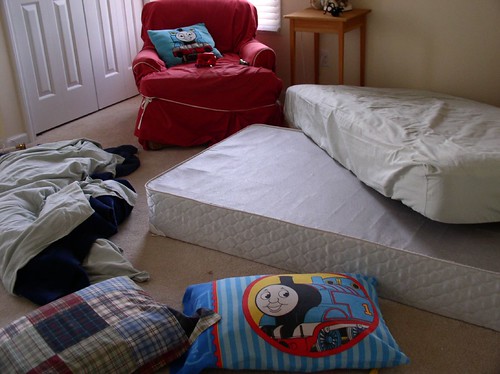
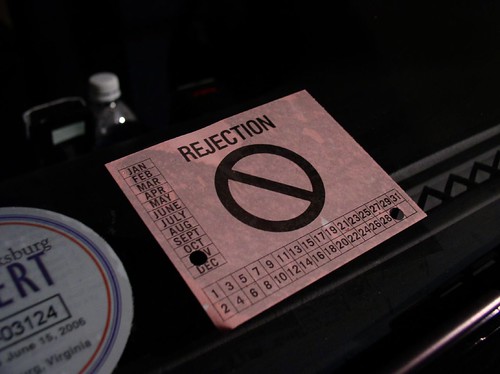
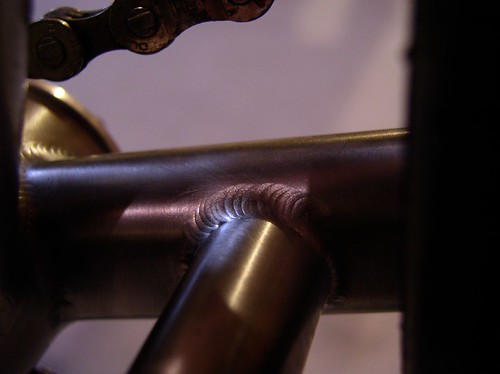
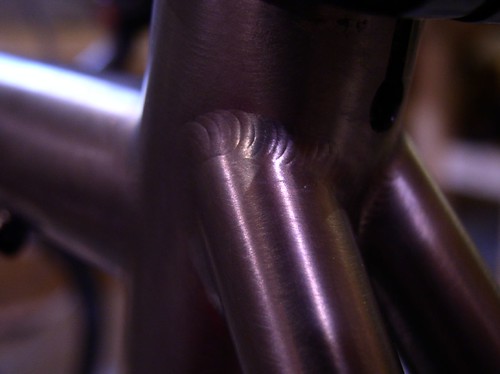
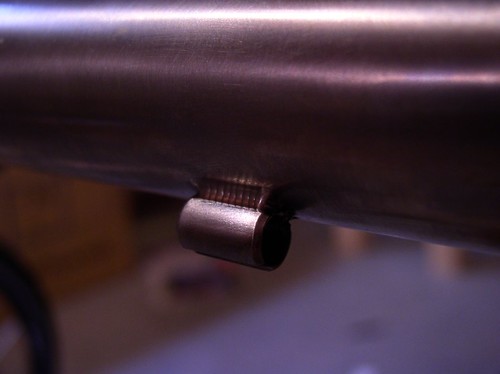
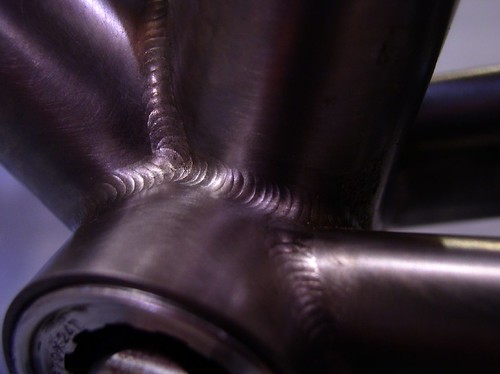
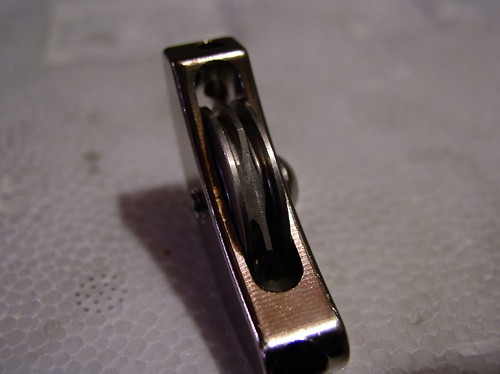
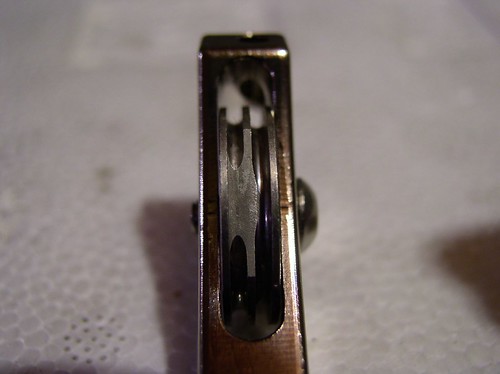
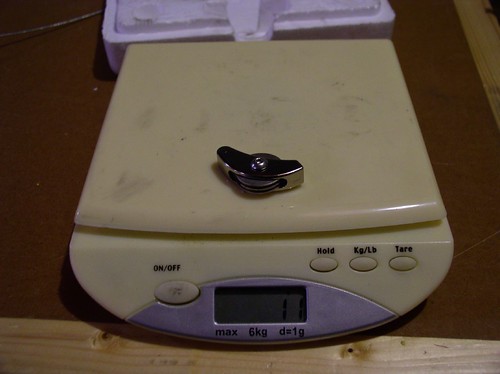
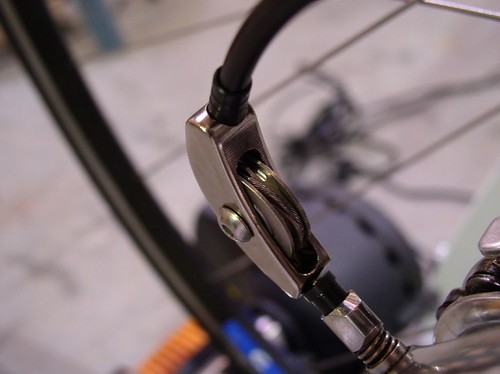


 Otherwise known as drink beer, wear camo and blaze orange and shoot anything that moves. I could here the BOOM BOOM BOOM off the mountain that morning. So I suggested going to
Otherwise known as drink beer, wear camo and blaze orange and shoot anything that moves. I could here the BOOM BOOM BOOM off the mountain that morning. So I suggested going to  . Got the last cabin they had
. Got the last cabin they had
